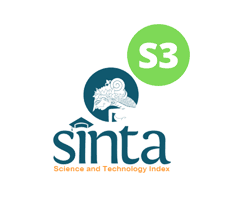Studi evaluasi jalur pedestrian di Jalan Raya Modo, Kabupaten Lamongan
DOI:
https://doi.org/10.24843/JAL.2025.v11.i01.p08Keywords:
evaluation, hardscape, importance performance analysis, pedestrian, softscapeAbstract
The pedestrian track on Jalan Raya Modo is the sidewalk used by the community, usually they use it to go to public facilities such as markets, banks, government offices and schools. The bottom of the sidewalk also functions as a drainage. However, the pedestrian track on Jalan Raya Modo also has several problems, including the disconnection path, hardscape damage, land use change of the pedestrian track to selling area, parking, and gardening using pots. The purpose of this study is evaluating the hardscape and softscape elements on pedestrian track on Jalan Raya Modo and make a recommendation for pedestrian track by redesign concepts. The research was using the questionnaire method with random sampling of 90 respondents and Importance Performance Analysis, this analysis aims to measure the relationship between
pedestrian track users and improved facilities. Based on the results, the
main priority for improvement is add the crossing path, repair of sidewalk
damage, and addition the trash bins. The facilities that need to be
maintained are the addition of vegetation like the tree, shrub, and
groundcover, and also the plants that easy to maintain.
References
BPS Kabupaten Lamongan. Kecamatan Modo Dalam Angka 2022. Diperoleh 11 September, 2022, dari
https://lamongankab.bps.go.id/publication.html
Direktorat Jenderal Bina Marga. Tata Cara Perencanaan Teknik Lansekap Jalan. Diperoleh 18 Juni, 2022, dari https://binamarga.pu.go.id/
Handoko, B. (2019). Analisis Penyalahgunaan Trotoar Di Beberapa Jalan Di Kota Medan [Universitas
Muhammadiyah Sumatera Utara]. http://repository.umsu.ac.id/handle/123456789/7804
Iswanto, Danoe (2006) Pengaruh Elemen-Elemen Pelengkap Jalur Pedestrian terhadap Kenyamanan Pejalan Kaki. ENCLOSURE 5 (1), 21-29 http://eprints.undip.ac.id/18474/
Kementrian PUPR. Pedoman Bahan Kontruksi Bangungan dan Rekayasa Sipil Perencanaan Teknis Fasilitas Pejalan Kaki. Diperoleh 20 Juni, 2022, dari https://simk.bpjt.pu.go.id/Landing_page/v_pedoman
Wati,H. M., & Widyawati, N. (2019). Evaluasi Aspek Fisik dan Kenyamanan Pedestrian di Jalan Diponegoro Salatiga melalui Persepsi Masyarakat. Jurnal Lanskap Indonesia, 11(1), 26-32. https://journal.ipb.ac.id/index.php/jli/article/view/20670/20315
Menteri Pekerjaan Umum Republik Indonesia. Pedoman Perencanaan, Penyediaan, dan Pemanfaatan
Prasarana dan Sarana Jaringan Pejalan Kaki di Kawasan Perkotaan. Diperoleh 20 Juni, 2022 dari
https://pug-pupr.pu.go.id/_uploads/Produk_Pengaturan/Permen%20PUPR%20No%2003-2014.pdf
Peraturan Presiden. Undang-Undang Republik Indonesia Nomor 38 Tahun 2004 Tentang Jalan. Diperoleh 18 Juni, 2022 dari https://peraturan.bpk.go.id/Home/Details/40785/uu-no-38-tahun-2004
Sakinah, R., et al (2018). Kriteria jalur pedestrian di Indonesia. Jurnal Lingkungan Binaan Indonesia, 7(2), 81-85. https://www.researchgate.net/publication/327888488_Kriteria_Jalur_Pedestrian_di_Indonesia
Martilla J. A. dan James J. C. (1977). Importance-Performance Analysis. The Journal of Marketing, 41(1), 77-79 https://slunik.slu.se/kursfiler/F%C3%960349/10294.1314/Martilla_James_1977.pdf
Downloads
Published
Issue
Section
License

This work is licensed under a Creative Commons Attribution-ShareAlike 4.0 International License.
An author who publishes in the Jurnal Arsitektur Lansekap (JAL) agrees to the following terms:
- Author retains the copyright and grants the journal the right of first publication of the work simultaneously licensed under the Creative Commons Attribution-ShareAlike 4.0 License that allows others to share the work with an acknowledgement of the work's authorship and initial publication in this journal
- Author is able to enter into separate, additional contractual arrangements for the non-exclusive distribution of the journal's published version of the work (e.g., post it to an institutional repository or publish it in a book) with the acknowledgement of its initial publication in this journal.
- Author is permitted and encouraged to post his/her work online (e.g., in institutional repositories or on their website) prior to and during the submission process, as it can lead to productive exchanges, as well as earlier and greater citation of the published work (See The Effect of Open Access).
Read more about the Creative Commons Attribution-ShareAlike 4.0 Licence here: https://creativecommons.org/licenses/by-sa/4.0/.


















